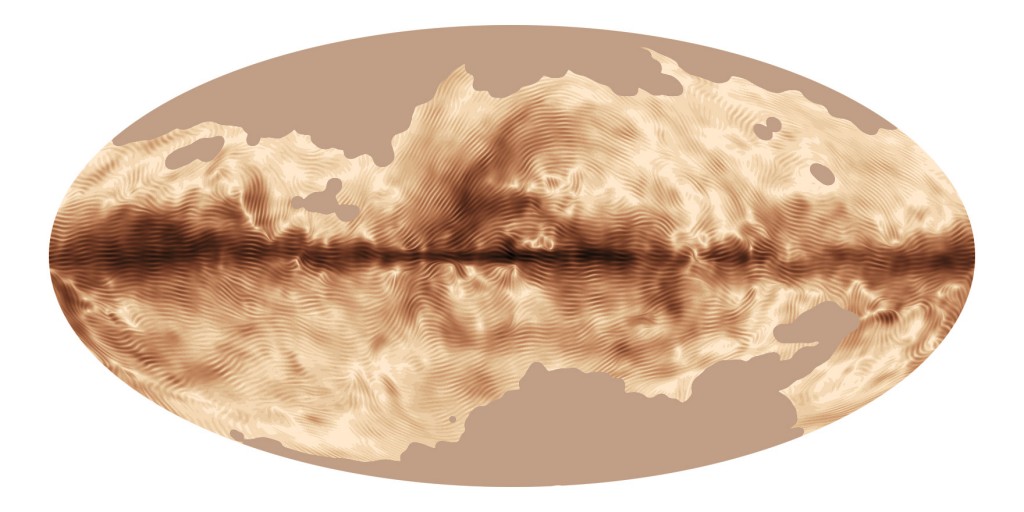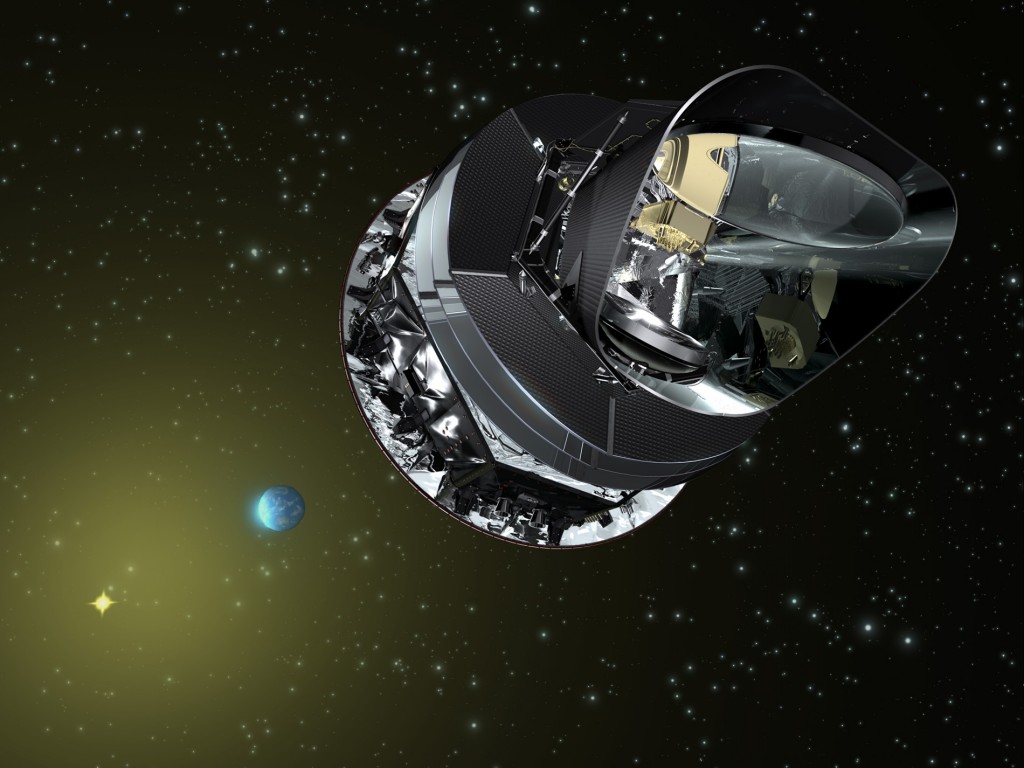Planck Reveals Magnetic Fingerprint of Our Galaxy

The magnetic field of our Milky Way Galaxy as seen by ESA’s Planck satellite. Credit: ESA and the Planck Collaboration
The team—which includes researchers from the University of British Columbia and the Canadian Institute for Theoretical Astrophysics (CITA) at the University of Toronto—created the map using data from the Planck Space Telescope. Since 2009, Planck has charted the Cosmic Microwave Background (CMB), the light from the Universe a mere 380,000 years after the Big Bang.
But Planck also observes light from much closer than the farthest reaches of time and space. With an instrument called the High Frequency Instrument (HFI), Planck detects the light from microscopic dust particles within our Galaxy. (The density of this dust is incredibly low; a volume of space equal to a large sports stadium or arena would contain one grain.)
Planck’s HFI identifies the non-random direction in which the light waves vibrate—known as polarization. It is this polarized light that indicates the orientation of the field lines.
“Just as the Earth has a magnetic field, our Galaxy has a large-scale magnetic field—albeit 100,000 times weaker than the magnetic field at the Earth’s surface,” says team member Prof. Douglas Scott (UBC). “And just as the Earth’s magnetic field generates phenomena such as the aurorae, our Galaxy’s magnetic field is important for many phenomena within it.”
For example, the magnetic field governs the coupling of the motions of gas and dust between stars, and so plays a role in star formation and the dynamics of cosmic rays.
“And now,” says Scott, “Planck has given us the most detailed picture of it yet.”
The “fingerprint” and other results are described in four papers to released May 6 (links below) and to be published in the journal Astronomy & Astrophysics.
Prof. Peter Martin (CITA; Interim Director, Dunlap Institute) uses Planck data to study the dust found throughout our Galaxy. According to Martin, “Dust is often overlooked but it contains the stuff from which terrestrial planets and life form. So by probing the dust, Planck helps us understand the complex history of the Galaxy as well as the life within it.”
Also, for cosmologists studying the origin and evolution of the Universe, data to be released later this year by scientists from the Planck collaboration should allow astronomers to separate with great confidence any possible foreground signal from our Galaxy from the tenuous, primordial, polarized signal from the CMB. In March 2014, scientists from the BICEP2 collaboration claimed the first detection of such a signal.
The Planck data will enable a much more detailed investigation of the early history of the cosmos, from the accelerated expansion when the Universe was much less than one second old to the period when the first stars were born, several hundred million years later.
And according to Prof. J. Richard Bond (CITA), “These results help us lift the veil of emissions from these tiny but pervasive Galactic dust grains which obscure a Planck goal of peering into the earliest moments of the Big Bang to find evidence for gravitational waves created in that epoch, as reported by BICEP2.”
Planck includes contributions from the Canadian Space Agency (CSA). The CSA funds two Canadian research teams that are part of the Planck science collaboration, and who helped develop both of Planck’s complementary science instruments, the High Frequency Instrument (HFI) and the Low Frequency Instrument (LFI). Professors J. Richard Bond of the University of Toronto (Director of Cosmology and Gravity at the Canadian Institute for Advanced Research) and Douglas Scott of the University of British Columbia lead the Canadian Planck team, which includes members from the University of Alberta, Université Laval and McGill University.
-30-
Papers:
To view papers: http://www.sciops.esa.int/index.php?project=PLANCK&page=Planck_Published_Papers
http://arxiv.org/list/astro-ph/new
Contact Information
Professor Peter Martin
Canadian Institute for Theoretical Astrophysics
Dunlap Institute for Astronomy & Astrophysics
University of Toronto
p: 416-978-6840
e: pgmartin@cita.utoronto.ca
Professor Douglas Scott
Department of Physics & Astronomy
University of British Columbia
p: 604-822-2802
e: dscott@phas.ubc.ca
Professor J. Richard Bond
Canadian Institute for Theoretical Astrophysics
University of Toronto
p: 416-978-6874
e: bond@cita.utoronto.ca
Brian Lin M.J.
Senior Media Relations Specialist, Public Affairs Office
The University of British Columbia
p: 604-822 2234
cell: 604-818-5685
e: brian.lin@ubc.ca
Chris Sasaki
Communications Coordinator
Dunlap Institute for Astronomy & Astrophysics
University of Toronto
p: 416-978-6613
e: csasaki@dunlap.utoronto.ca
The Canadian Institute for Theoretical Astrophysics is a nationally supported research center that is devoted to studying the origin and evolution of the universe, and the many wonderful phenomena revealed by modern astronomy. CITA fosters interaction within the community of Canadian astrophysics through workshops and a vibrant visitor program. CITA educates and develops the next generation of scientific leaders via National Postdoctoral Fellowships, Postdoctoral Fellows, and Senior Research Associate Fellowships, and through student supervision at the undergraduate and graduate level. Alumni of CITA’s post-doctoral programs hold distinguished positions across Canada and around the globe.
The University of British Columbia (UBC) is one of North America’s largest public research and teaching institutions,and is consistently ranked among the world’s 40 best universities. Surrounded by the beauty of the Canadian West, it is a place that inspires bold, new ways of thinking that have helped make it a national leader in areas as diverse as community service learning, sustainability and research commercialization. UBC offers more than 56,000 students a range of innovative programs and attracts $550 million per year in research funding from government, non-profit organizations and industry through over 8,000 projects and grants.
The Dunlap Institute for Astronomy & Astrophysics, University of Toronto, continues the legacy of the David Dunlap Observatory: by developing innovative astronomical instrumentation, including for the largest, most advanced telescopes in the world; by training the next generation of astronomers; and by fostering public engagement in science. The research of its faculty and postdoctoral fellows includes the discovery of exoplanets, the formation of stars, galactic nuclei, the evolution and nature of galaxies, the early Universe and the Cosmic Microwave Background, and the Search for Extra-terrestrial Intelligence (SETI).
###

